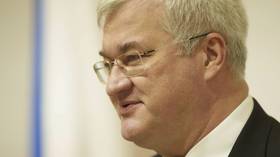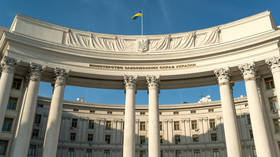Temperatures climb to 38C in COLDEST city on Earth - records broken as Russian Arctic endures more ANOMALOUS hot weather

Scientists are already alarmed at the spike in temperatures in Russia this year. While the mercury is creeping up everywhere, in Siberia it has spiked dramatically, delivering unprecedented heat.
This summer is on course to be the hottest since record-keeping began, in the world's largest country. Towns usually still blanketed by snow at this time of year are experiencing a blazing heatwave, thanks to the escalating climate crisis.
The effects of global warming have arrived and are already causing problems, especially in Siberia. A massive oil spill in the far northern mining city of Norilsk earlier this year was declared a federal emergency, after a pipeline sank into the mud and broke. The accident, which will take decades to clean up, was blamed on melting permafrost – the result of unusually high temperatures.
A week later, a once-in-a-thousand-year snowmelt in the northern city of Murmansk caused a local hydropower station to be flooded. No damage was done, but the plant was put on emergency alert as the water levels rose dramatically after snow at the nearby lake melted due to atypical heat.
On June 20, the Weather and Climate weather portal recorded a temperature of 38C in Verkhoyansk, in the Sakha Republic in Russia’s Far East – the coldest town in the world, with a record all-time low of -67.8C.The new high of 38C (over 100 degrees fahrenheit), if accurate, is the highest temperature ever recorded inside the Arctic Circle, meteorologists say.
The previous record of 37.8C was set in the US – at Fort Yukon, Alaska, to be precise – in June 1915. It had previously shared the record with Verkhoyansk.
Verkhoyansk also holds the Guinness World Record for the highest-recorded temperature range (105C), fluctuating from -68C to a high of 37C. The weather forecast in Verkhoyansk usually makes for pretty sobering reading. The outlook for the coming week is that temperatures will fall to the mid-30s, but that’s still a full 10 degrees higher than would be normal for late June.
Russia is warming at more than twice the rate of the rest of the world, according to scientists. Average temperatures are now 5.3С above those of 1951–1980, and have surpassed the previous record by a “massive” 1.9 C, Berkeley Earth project lead scientist Robert Rohde said, cited by the Guardian. Scientists expect 2020 to rank among the world’s five warmest years in recorded history.
Also on rt.com 100 degrees Fahrenheit! Eastern Siberian town shatters record for hottest-ever temperature inside Arctic CircleRussia has just been through the balmiest winter for 130 years, with Muscovites complaining there was no snow in December. The Ukrainian capital, Kiev, was likewise bare of snow until very late into the winter. Moscow usually spends hundreds of millions of dollars on its “snow brigades” – an army of workers that works around the clock to keep the roads open to traffic and the pavements clear for pedestrians by constantly clearing tonnes of snow after every major fall.
Unwelcome warm weather
The warm weather has also caused economic problems, as the lack of demand for heating has led to a European gas glut. Prices fell to below $100 per thousand cubic meters for the first time in years, due to the lack of demand. Only four years ago, they were four times higher, but there’s so much spare gas this year, producers are running out of places to store it.
Agriculture, another major export product, will also suffer, as the unusually dry spring is expected to bring down crop yields this year by up to 10 percent. Russia earned around $25 billion from grain exports last year, which is about $10 billion more than it earns from arms exports, and makes it the country’s second-biggest export product after raw materials.
Rising temperatures in Russia threaten some of its most valuable real estate, as most of its oil and gas pipeline infrastructure bringing the hydrocarbons to market from the inhospitable frozen interior is built over permafrost. If the permafrost melts, then much of this infrastructure could sink into a quagmire, causing tens of billions of dollars of damage.
Several settlements, many of them built in Soviet times to house workers at mines throughout Russia’s vast hinterland to exploit its natural resources, could also sink into the mud, as many buildings are standing on piles drilled into the permafrost and will collapse if it melts.
Russia has recently signed off on the Paris Accord and has started to think about measures to combat the climate crisis, but as bne IntelliNews reported in “The Cost of Carbon in Russia”, its actions so far have been half-hearted and the Kremlin has set itself easy goals that won’t result in much change or cost.
The trillion tonnes of prehistoric CO2 timebomb
The melting of the permafrost will not just threaten Russia’s economic interests, but could also cause a catastrophic one-time change to the atmosphere that would send temperatures up by several degrees overnight, with unpredictable consequences.
One trillion tonnes of prehistoric carbon dioxide have been trapped in the permafrost since the time of the dinosaurs. Scientists say this could suddenly be released all in one go, if the average temperature of the ground in Russia’s taiga, or snow forest, rises above 0C.
Currently, the average temperature in the massive tracts of taiga east of the Ural mountains is -3C, but scientists say it’s rising by about 1C a decade, and the irreversible release of pre-historical CO2 is still three decades away. However, this year’s heatwave suggests the process of heating up the frozen ground might be happening faster than expected.
Currently, the only effort to slow down the warming of the permafrost is being carried out independently of the government, by the father-and-son team of Sergey and Nikita Zimov, who live in Novosibirsk in Siberia. They’ve established a 14,000-hectare reserve near Chersky called Pleistocene Park and are trying to bring deer, moose and elk to it. These animals trample the snow, packing it down, which forms an isolating layer over the permafrost and prevents it from warming as quickly.
Also on rt.com Massive wildfires continue to rage in Siberia, emergency declared in several regions (VIDEO)Founded by the elder Zimov 19 years ago, the park nonetheless represents only a tiny fraction of the permafrost fields that stretch almost halfway around the planet.
To work, the Zimovs say they need 20 large beasts per square kilometer, which would entail millions of animals being imported into the region. Most of those the Zimovs have brought to their park so far have either died or escaped.
Currently, their herd consists of a total of just 70. It’s a mammoth task, but one has to admire their pluck – and their optimism.
Think your friends would be interested? Share this story!














